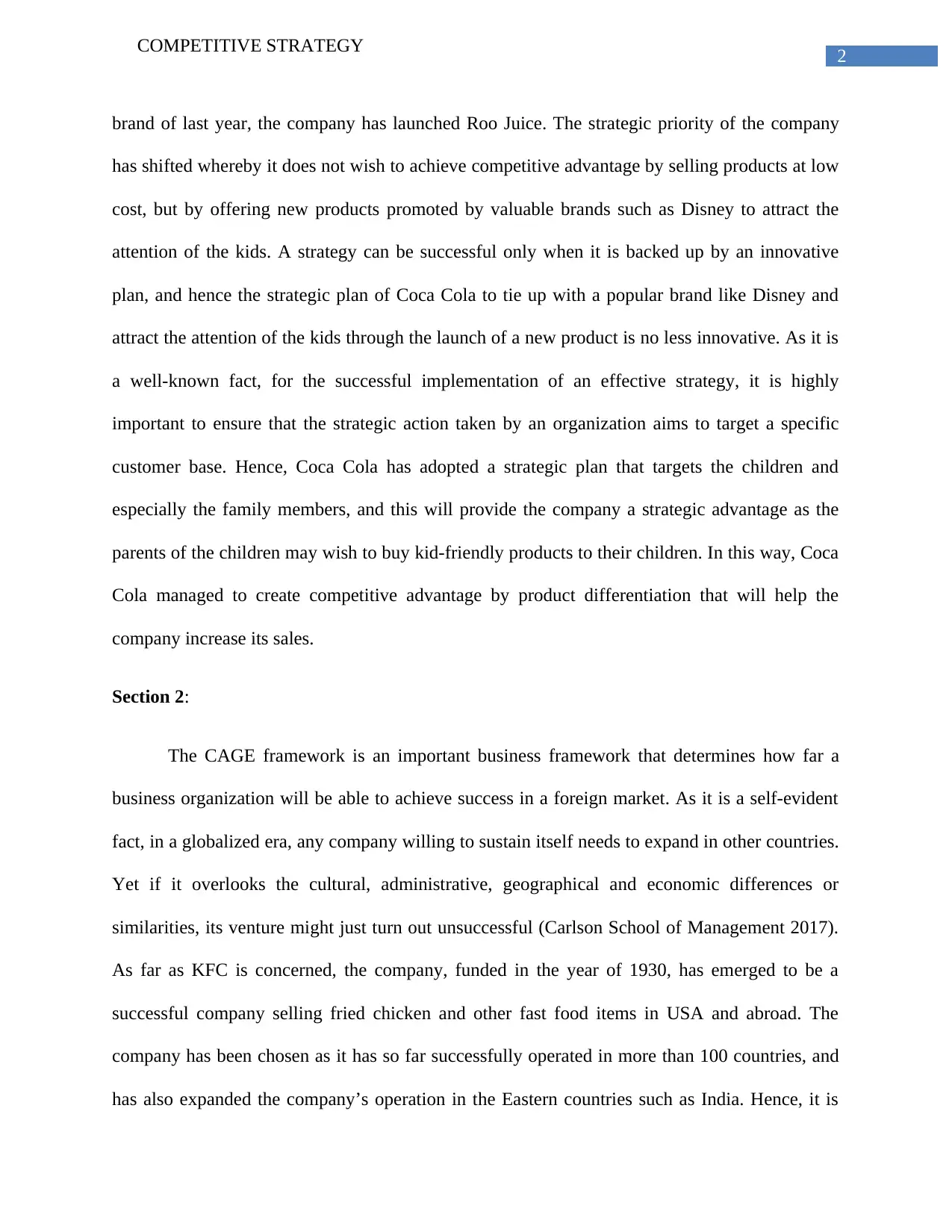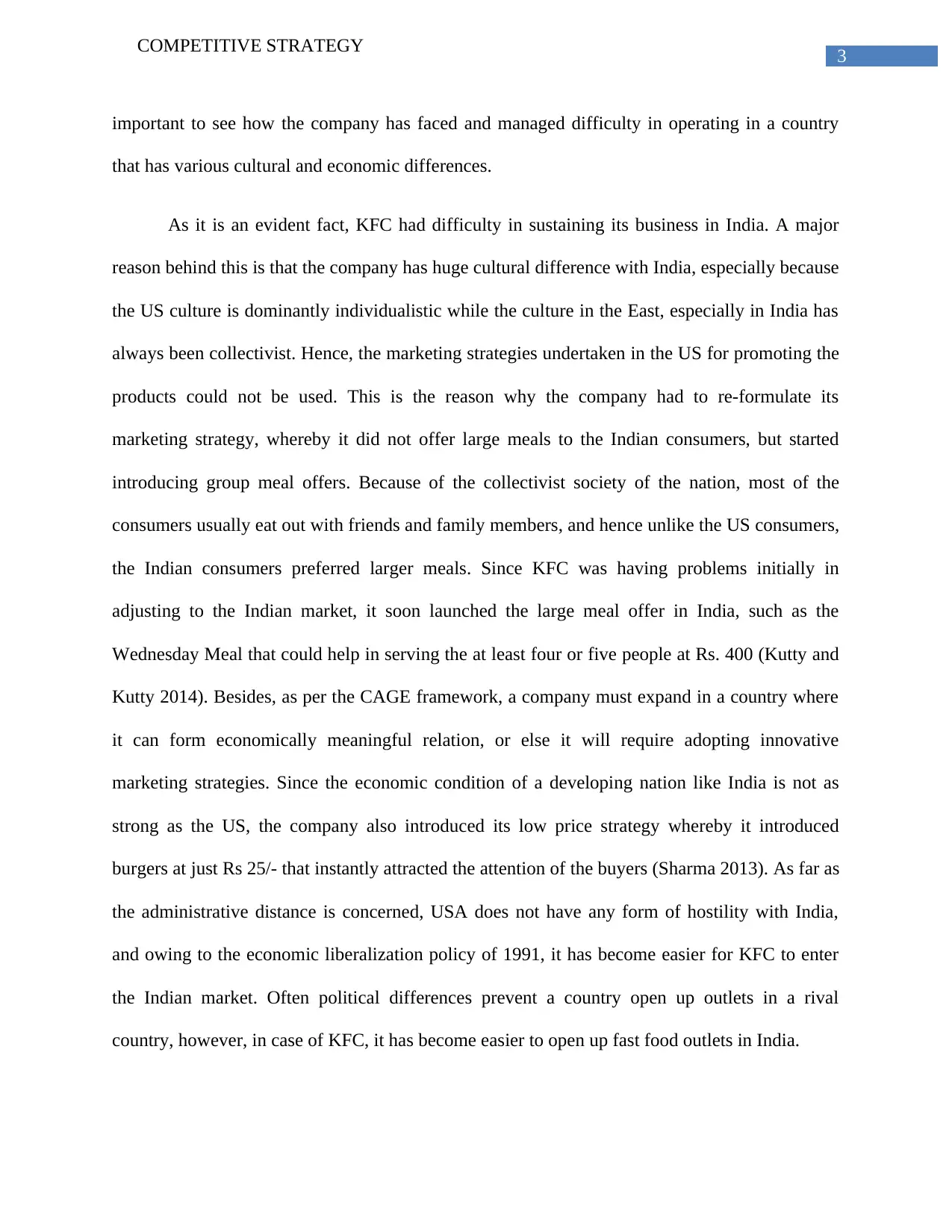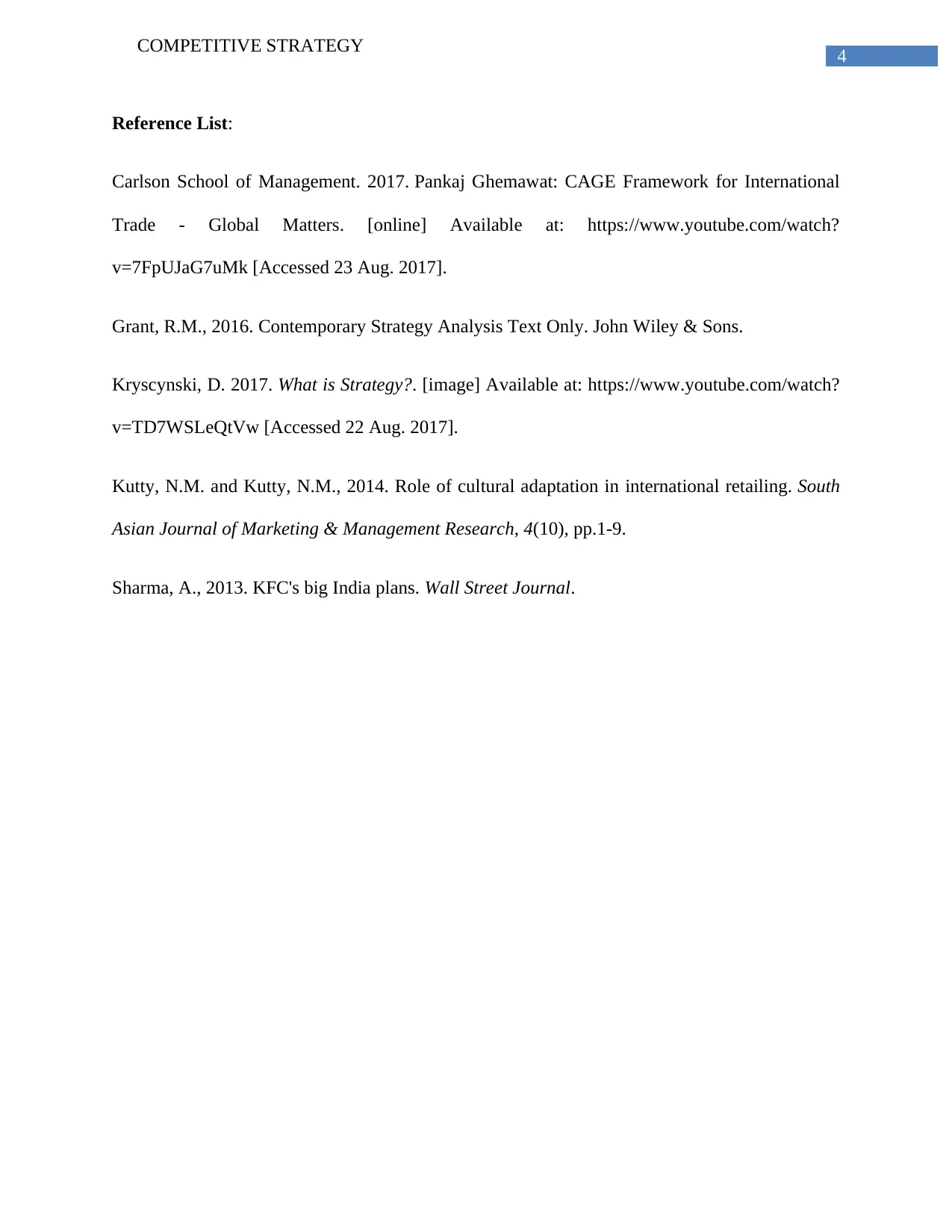University Report: Competitive Strategies of Coca-Cola and KFC
VerifiedAdded on 2020/03/02
|5
|1248
|131
Report
AI Summary
This report examines the competitive strategies of two major companies: Coca-Cola and KFC. The first section analyzes Coca-Cola's strategy to maintain its competitive edge in the soft drink market, focusing on product differentiation, particularly the launch of new products like Roo Juice, and its strategic partnerships to attract a broader customer base, especially families with children. The second section applies the CAGE framework to KFC's international expansion, specifically its challenges and adaptations in the Indian market. It explores how KFC addressed cultural differences, adjusted its marketing strategies, and implemented price strategies to succeed in India. The report highlights the importance of understanding cultural, administrative, geographical, and economic factors for successful international business operations. It emphasizes the role of innovation and strategic planning in achieving competitive advantage and long-term sustainability.

Running head: COMPETITIVE STRATEGY
Competitive Strategy
Name of the Student:
Name of the University:
Author note:
Competitive Strategy
Name of the Student:
Name of the University:
Author note:
Paraphrase This Document
Need a fresh take? Get an instant paraphrase of this document with our AI Paraphraser

1
COMPETITIVE STRATEGY
Section 1:
The importance of business strategy in conducting successful business can never be
overstated. In fact, it is the business strategy alone that highlights the strategic plan adopted by
an organization to achieve its goals. Founded back in the year of 1886, Coca Cola has evolved
itself to become the most recognized brand operating in the soft carbonated drink industry and
yet the company has been facing throat-cut competition from brands like Pepsi. Hence, it is
important to see how Coca Cola has employed an effective strategy in order to maintain
competitive edge in the market and ensure long-term sustainability.
Before analyzing the strategy of Coca Cola, it is important to understand why has it
become imperative for the company to adopt a strategy (Kryscynski 2017). As it is a well-known
fact, despite the strong brand reputation of the company, the company has been facing intense
competition from other rival giants such as Pepsi and Dr. Pepper Snapple Group. Hence, the
immediate objective of the company has become to attract larger customer base than before and
thereby boost its sales growth and annual revenue. However, this organizational goal needed to
be accompanied by a strong organizational strategy. Hence, the company formulated a strategy
that would aid in its product differentiation and enable it to attract larger customer base.
Accordingly, the company has launched its Roo Juice, a joint venture between Coca-Cola and
Disney that is expected to boost the competitive growth of the company. In fact, the company
has previously launched a variety of beverages such as Diet Coke to ensure that it is able to tap
the attention of a specific customer base. However, since its competitors were also producing
similar group of products attracting the youth customer base, the company re-formulated its
strategy to produce family beverages (Gant 2016). As a result, following the Mickey Mouse milk
COMPETITIVE STRATEGY
Section 1:
The importance of business strategy in conducting successful business can never be
overstated. In fact, it is the business strategy alone that highlights the strategic plan adopted by
an organization to achieve its goals. Founded back in the year of 1886, Coca Cola has evolved
itself to become the most recognized brand operating in the soft carbonated drink industry and
yet the company has been facing throat-cut competition from brands like Pepsi. Hence, it is
important to see how Coca Cola has employed an effective strategy in order to maintain
competitive edge in the market and ensure long-term sustainability.
Before analyzing the strategy of Coca Cola, it is important to understand why has it
become imperative for the company to adopt a strategy (Kryscynski 2017). As it is a well-known
fact, despite the strong brand reputation of the company, the company has been facing intense
competition from other rival giants such as Pepsi and Dr. Pepper Snapple Group. Hence, the
immediate objective of the company has become to attract larger customer base than before and
thereby boost its sales growth and annual revenue. However, this organizational goal needed to
be accompanied by a strong organizational strategy. Hence, the company formulated a strategy
that would aid in its product differentiation and enable it to attract larger customer base.
Accordingly, the company has launched its Roo Juice, a joint venture between Coca-Cola and
Disney that is expected to boost the competitive growth of the company. In fact, the company
has previously launched a variety of beverages such as Diet Coke to ensure that it is able to tap
the attention of a specific customer base. However, since its competitors were also producing
similar group of products attracting the youth customer base, the company re-formulated its
strategy to produce family beverages (Gant 2016). As a result, following the Mickey Mouse milk

2
COMPETITIVE STRATEGY
brand of last year, the company has launched Roo Juice. The strategic priority of the company
has shifted whereby it does not wish to achieve competitive advantage by selling products at low
cost, but by offering new products promoted by valuable brands such as Disney to attract the
attention of the kids. A strategy can be successful only when it is backed up by an innovative
plan, and hence the strategic plan of Coca Cola to tie up with a popular brand like Disney and
attract the attention of the kids through the launch of a new product is no less innovative. As it is
a well-known fact, for the successful implementation of an effective strategy, it is highly
important to ensure that the strategic action taken by an organization aims to target a specific
customer base. Hence, Coca Cola has adopted a strategic plan that targets the children and
especially the family members, and this will provide the company a strategic advantage as the
parents of the children may wish to buy kid-friendly products to their children. In this way, Coca
Cola managed to create competitive advantage by product differentiation that will help the
company increase its sales.
Section 2:
The CAGE framework is an important business framework that determines how far a
business organization will be able to achieve success in a foreign market. As it is a self-evident
fact, in a globalized era, any company willing to sustain itself needs to expand in other countries.
Yet if it overlooks the cultural, administrative, geographical and economic differences or
similarities, its venture might just turn out unsuccessful (Carlson School of Management 2017).
As far as KFC is concerned, the company, funded in the year of 1930, has emerged to be a
successful company selling fried chicken and other fast food items in USA and abroad. The
company has been chosen as it has so far successfully operated in more than 100 countries, and
has also expanded the company’s operation in the Eastern countries such as India. Hence, it is
COMPETITIVE STRATEGY
brand of last year, the company has launched Roo Juice. The strategic priority of the company
has shifted whereby it does not wish to achieve competitive advantage by selling products at low
cost, but by offering new products promoted by valuable brands such as Disney to attract the
attention of the kids. A strategy can be successful only when it is backed up by an innovative
plan, and hence the strategic plan of Coca Cola to tie up with a popular brand like Disney and
attract the attention of the kids through the launch of a new product is no less innovative. As it is
a well-known fact, for the successful implementation of an effective strategy, it is highly
important to ensure that the strategic action taken by an organization aims to target a specific
customer base. Hence, Coca Cola has adopted a strategic plan that targets the children and
especially the family members, and this will provide the company a strategic advantage as the
parents of the children may wish to buy kid-friendly products to their children. In this way, Coca
Cola managed to create competitive advantage by product differentiation that will help the
company increase its sales.
Section 2:
The CAGE framework is an important business framework that determines how far a
business organization will be able to achieve success in a foreign market. As it is a self-evident
fact, in a globalized era, any company willing to sustain itself needs to expand in other countries.
Yet if it overlooks the cultural, administrative, geographical and economic differences or
similarities, its venture might just turn out unsuccessful (Carlson School of Management 2017).
As far as KFC is concerned, the company, funded in the year of 1930, has emerged to be a
successful company selling fried chicken and other fast food items in USA and abroad. The
company has been chosen as it has so far successfully operated in more than 100 countries, and
has also expanded the company’s operation in the Eastern countries such as India. Hence, it is
⊘ This is a preview!⊘
Do you want full access?
Subscribe today to unlock all pages.

Trusted by 1+ million students worldwide

3
COMPETITIVE STRATEGY
important to see how the company has faced and managed difficulty in operating in a country
that has various cultural and economic differences.
As it is an evident fact, KFC had difficulty in sustaining its business in India. A major
reason behind this is that the company has huge cultural difference with India, especially because
the US culture is dominantly individualistic while the culture in the East, especially in India has
always been collectivist. Hence, the marketing strategies undertaken in the US for promoting the
products could not be used. This is the reason why the company had to re-formulate its
marketing strategy, whereby it did not offer large meals to the Indian consumers, but started
introducing group meal offers. Because of the collectivist society of the nation, most of the
consumers usually eat out with friends and family members, and hence unlike the US consumers,
the Indian consumers preferred larger meals. Since KFC was having problems initially in
adjusting to the Indian market, it soon launched the large meal offer in India, such as the
Wednesday Meal that could help in serving the at least four or five people at Rs. 400 (Kutty and
Kutty 2014). Besides, as per the CAGE framework, a company must expand in a country where
it can form economically meaningful relation, or else it will require adopting innovative
marketing strategies. Since the economic condition of a developing nation like India is not as
strong as the US, the company also introduced its low price strategy whereby it introduced
burgers at just Rs 25/- that instantly attracted the attention of the buyers (Sharma 2013). As far as
the administrative distance is concerned, USA does not have any form of hostility with India,
and owing to the economic liberalization policy of 1991, it has become easier for KFC to enter
the Indian market. Often political differences prevent a country open up outlets in a rival
country, however, in case of KFC, it has become easier to open up fast food outlets in India.
COMPETITIVE STRATEGY
important to see how the company has faced and managed difficulty in operating in a country
that has various cultural and economic differences.
As it is an evident fact, KFC had difficulty in sustaining its business in India. A major
reason behind this is that the company has huge cultural difference with India, especially because
the US culture is dominantly individualistic while the culture in the East, especially in India has
always been collectivist. Hence, the marketing strategies undertaken in the US for promoting the
products could not be used. This is the reason why the company had to re-formulate its
marketing strategy, whereby it did not offer large meals to the Indian consumers, but started
introducing group meal offers. Because of the collectivist society of the nation, most of the
consumers usually eat out with friends and family members, and hence unlike the US consumers,
the Indian consumers preferred larger meals. Since KFC was having problems initially in
adjusting to the Indian market, it soon launched the large meal offer in India, such as the
Wednesday Meal that could help in serving the at least four or five people at Rs. 400 (Kutty and
Kutty 2014). Besides, as per the CAGE framework, a company must expand in a country where
it can form economically meaningful relation, or else it will require adopting innovative
marketing strategies. Since the economic condition of a developing nation like India is not as
strong as the US, the company also introduced its low price strategy whereby it introduced
burgers at just Rs 25/- that instantly attracted the attention of the buyers (Sharma 2013). As far as
the administrative distance is concerned, USA does not have any form of hostility with India,
and owing to the economic liberalization policy of 1991, it has become easier for KFC to enter
the Indian market. Often political differences prevent a country open up outlets in a rival
country, however, in case of KFC, it has become easier to open up fast food outlets in India.
Paraphrase This Document
Need a fresh take? Get an instant paraphrase of this document with our AI Paraphraser

4
COMPETITIVE STRATEGY
Reference List:
Carlson School of Management. 2017. Pankaj Ghemawat: CAGE Framework for International
Trade - Global Matters. [online] Available at: https://www.youtube.com/watch?
v=7FpUJaG7uMk [Accessed 23 Aug. 2017].
Grant, R.M., 2016. Contemporary Strategy Analysis Text Only. John Wiley & Sons.
Kryscynski, D. 2017. What is Strategy?. [image] Available at: https://www.youtube.com/watch?
v=TD7WSLeQtVw [Accessed 22 Aug. 2017].
Kutty, N.M. and Kutty, N.M., 2014. Role of cultural adaptation in international retailing. South
Asian Journal of Marketing & Management Research, 4(10), pp.1-9.
Sharma, A., 2013. KFC's big India plans. Wall Street Journal.
COMPETITIVE STRATEGY
Reference List:
Carlson School of Management. 2017. Pankaj Ghemawat: CAGE Framework for International
Trade - Global Matters. [online] Available at: https://www.youtube.com/watch?
v=7FpUJaG7uMk [Accessed 23 Aug. 2017].
Grant, R.M., 2016. Contemporary Strategy Analysis Text Only. John Wiley & Sons.
Kryscynski, D. 2017. What is Strategy?. [image] Available at: https://www.youtube.com/watch?
v=TD7WSLeQtVw [Accessed 22 Aug. 2017].
Kutty, N.M. and Kutty, N.M., 2014. Role of cultural adaptation in international retailing. South
Asian Journal of Marketing & Management Research, 4(10), pp.1-9.
Sharma, A., 2013. KFC's big India plans. Wall Street Journal.
1 out of 5
Related Documents
Your All-in-One AI-Powered Toolkit for Academic Success.
+13062052269
info@desklib.com
Available 24*7 on WhatsApp / Email
![[object Object]](/_next/static/media/star-bottom.7253800d.svg)
Unlock your academic potential
Copyright © 2020–2025 A2Z Services. All Rights Reserved. Developed and managed by ZUCOL.





